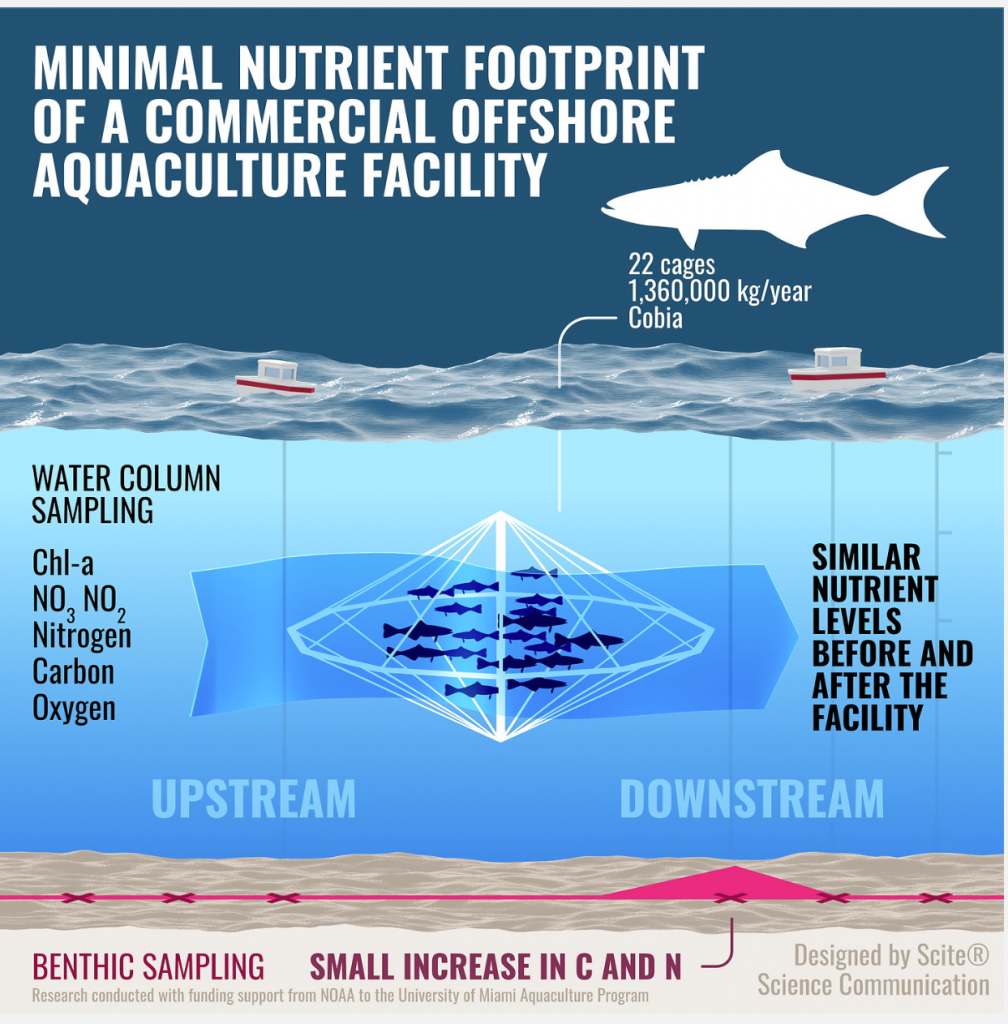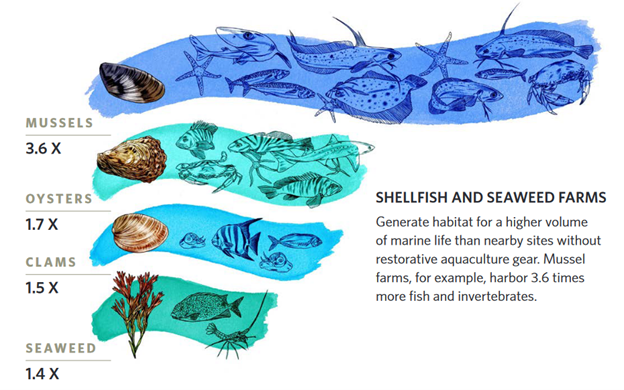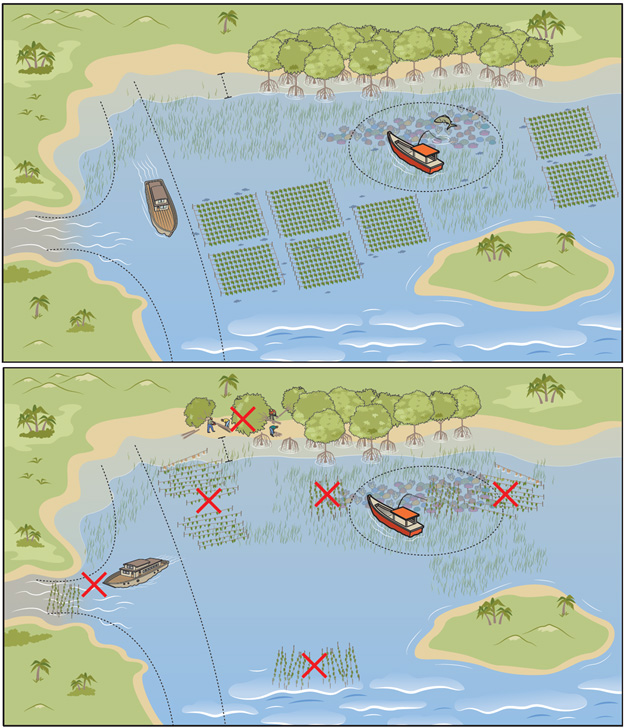Habitat
Nearshore marine environments are often characterized by sensitive and key habitats such as mangroves, nursery and spawning grounds, seagrass beds, and migratory routes. If aquaculture farms are not sited properly and correct managerial protocols are not strictly followed, long-term cage operations can cause detrimental impacts to the seafloor and to critically valuable environments.
Some of these negative effects on the environment caused by poorly sited and managed cages is reduction of abundance and diversity of local benthic species and habitats that are essential to the ecosystem, increase in dissolved organic solids and nutrients that the environment cannot sequester, decrease of water quality below safe levels, and impacts to sensitive ecosystems surrounding the cages. If permitters and managers follow strict siting protocols while taking into account numerous environmental factors, coastal aquaculture can have minimal impact on the environment.

Impact mitigation of aquaculture. When properly sited, fish farms can have a minimal effect on surrounding habitats and water quality. Source: Scite Science Communication
Aquaculture has also been shown to have beneficial impacts on the surrounding environment. Aquaculture gear and the organisms cultivated on and within them can provide three-dimensional structured habitat that can benefit fish and invertebrates. Farms can provide refugia for juvenile fish and invertebrates and aquaculture organisms and biofouling communities associated with farms can provide food resources.
In Madagascar, sea cucumber farms studied were found to positively impact seagrass meadows, increasing the growth rates of certain species. ref Sea cucumbers help oxygenate and loosen sediment through burying which can facilitate greater belowground seagrass growth. They also ingest and excrete large amounts of sediments, which provide seagrass with added nutrients to support growth. ref

Abundance of marine life at seaweed and shellfish farms. Source: TNC 2021
Site Selection
An incredibly important issue to consider when planning or permitting aquaculture farms in tropical reef areas is the distance from coral reefs. Coral reefs are sensitive ecosystems that provide shelter and nursery grounds to many reef fish and can be negatively affected by slight changes in water quality from nearby aquaculture. In finfish aquaculture, natural fish waste from a cage will slowly fall to the seafloor, which can build up on the seafloor if the cage is too shallow or if there is low flow. However, if good currents exist, waste can instead be transported downstream and dissipated in the environment; if ingoing and outgoing tides also exist, then waste can be transported and dispersed in both directions. ref
Similar to coral reefs, seagrass beds and other sensitive habitats (spawning grounds and nurseries) need to be considered during the planning and permitting phase. Seagrass beds provide food for marine mammals such as dugongs and habitat for fish, but fish waste or excess feed from cages can cover seagrass beds, blocking out light needed for photosynthesis. Horizontal distance as well as currents and tides need to be taken into account to safeguard the preservation of these sensitive habitats. ref
Depending on a variety of environmental parameters, species selection, and regulatory and permitting frameworks, the allowed distance of aquaculture farms to sensitive habitats can vary greatly, which makes it difficult to set a concrete and universal minimum distance. Here are a few examples to demonstrate how distance recommendations may differ depending on the country of origin, habitat to be protected, or by what organization or body is proposing such recommendation.
| Location | Environmental Parameter | Recommended Distance | Recommending Body |
|---|---|---|---|
| Gulf of Mexico, USA | Benthic communities | 152 m | Federal Agency (BOEM) |
| California, USA | Eelgrass beds | 10 m | Federal (NOAA) & State Agencies (CCC) |
| Palau | Coral reefs | 200 m (siting guideline) | Local government & NGO |
Source: Recommended Distance – United States Department of the Interior (Gulf of Mexico, USA), State of California Natural Resources Agency (California, USA), Hedberg et al. 2015 (Central Vietnam and Palau)
Waste generated from a finfish cage can be properly and naturally sequestered and utilized by the marine environment if there is proper current and the ecological limits of the environment are not exceeded. If excess nutrients are produced from the cage during feeding and the waste cannot be assimilated, they can build up and cause long-term damage to the local area. If excess feed and feces accumulate on the surrounding seafloor, increased respiration from microbial decomposition will lead to the depletion of oxygen in the sediment and alter its chemistry. As oxygen is depleted by microbial respiration, anaerobic bacteria will begin to prevail leading to hypoxic or anoxic conditions and to the production of carbon dioxide, nitrification of ammonia, and the reduction of manganese, iron and sulfur.
If the seafloor is allowed to shift towards an anaerobic bacterial community, mats of sulfide oxide will colonize the affected surface and will be the only visible organism. Seafloors beneath finfish cages that have undergone physical and chemical alteration have also seen changes in species composition and diversity. Studies have found that there is a shift towards more tolerant generalist organisms such as polychaetes, and a decrease in mollusks and crustaceans. ref

Example of good (top) vs poor (bottom) seaweed farm siting in Tanzania. Images © Colin Hayes/TNC
If proper planning and management are carried out while taking into account currents, tides, and the proper feeding protocols, it is possible to minimize negative impacts to the surrounding environment. ref Proper planning can also be used to maximize environmental benefits from seaweed or shellfish aquaculture. For example, siting a farm in an area where fish stocks face habitat limitations could have substantially greater environmental value than a farm sited in areas where wildlife is not limited by the availability of natural habitats. Similarly, a nutrient-extractive farm that is sited in a known eutrophic area will likely have greater water quality benefits than a farm sited in an area not experiencing nutrient pollution.
Seafloor Depth
Depending on the speed of the currents in the proposed or current cage site, greater depths may be needed to reduce impacts of fish waste and excess feed on surrounding environments. If the cage is located too close to a coral reef, effluents or derelict gear from the farm can sink to the seafloor and negatively impact the benthic environment. Additionally, if the cage is located in a shallow area above a seagrass bed, the cage has the potential to shade the seagrass and impact it’s growth and photosynthesis. ref See the Water Pollution section for more information on optimal depth.
Gear
Different types of gear and cage types can be used depending on the geography, specific site, selected species, size of operation, and funding available. If aquaculture gear is not designed properly, is of poor quality, or is not serviced regularly, it may detach or break from the cage and negatively impact local habitats, marine mammals, or travelling vessels. ref Depending on the gear and location, predators may be able to bite through the net to prey upon and damage the cultured species. However, if properly designed, sited, and maintained, cages can last for years without needing replacement.
Additionally, some types of gear are better at creating habitat and enhancing environmental benefits than others. Gear and supporting structures can increase foraging, breeding, and refuge habitat for wild fish and other species. For example, the culture of bivalves can create supplemental structure, mimic natural bivalve habitats, and facilitate the recruitment of wild seed. Cultivation gear that includes nets or other mesh material can serve as protection from predators for juvenile fish and can increase the abundance of species around the aquaculture site. Suspended culture, such as longline seaweed cultivation or mussel longline gear can provide a canopy that serves as a habitat for wild fish and invertebrate species.
Monitoring
Regulations should govern proper siting of aquaculture in the marine environment, and include requirements for monitoring, although this may not be the case in some countries. It is imperative to carry out monitoring of farm effluent, nearby water quality, and farm impacts during the production cycle to observe and record any habitat impacts that may be occurring. ref A good resource on monitoring aquaculture effluent is Guidelines on a Harmonized Environmental Monitoring Programme (EMP) for Marine Finfish Cage Farming in the Mediterranean and the Black Sea. An important aspect of monitoring is conducting a baseline assessment before installing any cage or gear to know what kind of changes occur during construction and operation of the cages.
